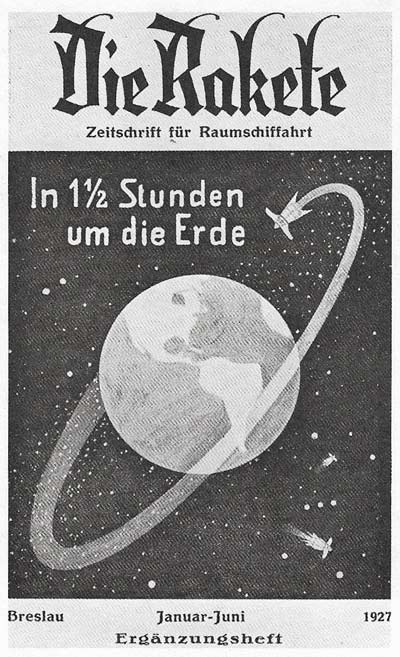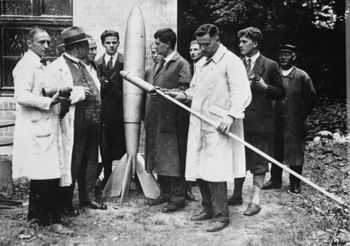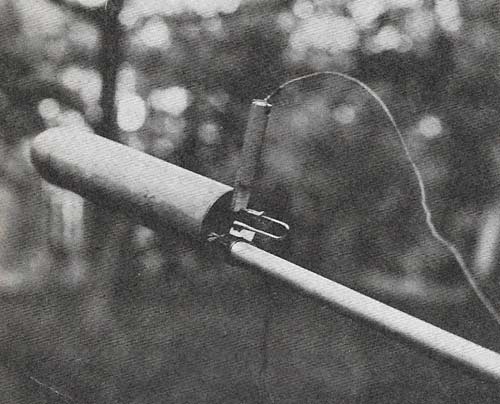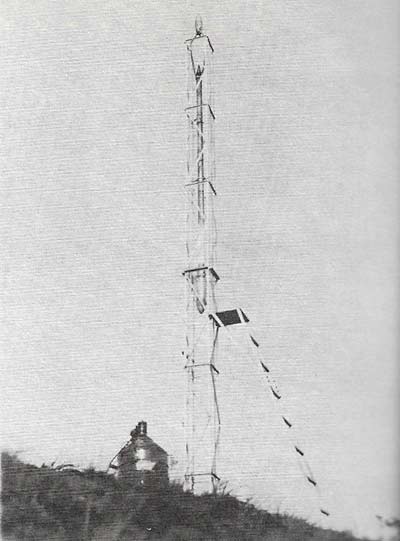Verein für Raumschiffahrt

Figure 1. In 1927 the German Society for Space Travel began publishing a twice-yearly journal, Die Rakete.

Figure 2. Members of the Verein für Raumschiffahrt, circa 1930. Left to right: Rudolf Nebel, Franz Ritter, unknown, Kurt Heinisch, unknown, Hermann Oberth, unknown, Klaus Riedel, Wernher von Braun, unknown.

Figure 3. Mirak 2 at the Raketenflugplatz. Liquid oxygen is in the large tank at the left; fuel is in the long, thin tank at the right.

Figure 4. The VfR experimenters designed an improved cooling system, aluminum cooled by water , for the Repulsor series. Repulsor 2, shown here on the test stand at Raketenflugplatz, was fired to 2,000 feet on 23 May 1931.
Verein für Raumschiffahrt (VfR), or Society for Space Travel, was an association of German enthusiasts which formed in 1927 and carried out important development work on liquid-fueled rockets. The stimulus for the society was the publication of Hermann Oberth's 1923 book Die Rakete zu den Planetenräumen (The Rocket Into Interplanetary Space). Membership of VfR rose rapidly to around 500 and the society began publishing its own journal, Die Rakete (Figure 1).
Impressed by Oberth's mathematically-sound theories that space travel was achievable, the founders of VfR set out to build the types of rockets he described (see Mirak). The group grew in size to about 500 members, produced its own journal, Die Rakete (The Rocket), and obtained permission to use an abandoned ammunition dump in Reinickendorf, a suburb of Berlin, as test site for its projects. The facility soon became known as the Raketenflugplatz (rocket airfield) and served as an early proving ground for several men who would go on to play a key role in the German Army's World War II rocket program. One of the brightest young people involved at the Raketenflugplatz was 19-year-old Wernher von Braun, later chosen to head the Army's rocket development program (Figure 2). By 1932, VfR had fallen on hard times and hoped to secure funds from the Army for further testing. After a demonstration launch failed to impress attending officers, society members knew their days at the Raketenflugplatz were numbered. Still, the Army was impressed by von Braun and he was invited to write his graduate thesis on rocket combustion at Kummersdorf.
Work at the Raketenflugplatz ended during the winter of 1933–1934. The VfR was in shaky financial condition and could not pay its accumulated bills. In January 1934, a year after Hitler's rise to power, the Raketenflugplatz was turned back into an ammunition dump by the military. The international ties of the VfR and the Raketenflugplatz, irritated the new regime, and it was not long before the Gestapo would make its presence felt. In this stfling atmosphere private interest in rocketry all but vanished.
After Hitler came to power, Nazi Germany banned all rocket experimentation or rocket discussion outside of the German military. The rocket enthusiasts who had populated the Raketenflugplatz had to abandon their work or continue it in the military. Hauptmann Dornberger was now able to successfully recruit former members of the VfR, many of whom joined the Army organization at Kummersdorf.
Mirak and Repulsor
Beginning in August 1930 the VfR-Raketenflugplatz experimenters tested a series of rockets called Mirak, a contraction of "Minimum Rakete." Mirak had a body about a foot long and a tail section about 3 feet long. The tail held the tank for the gasoline that fueled the rocket, while the oxidizer (liquid oxygen, or LOX) was stored in the head. The tiny copper motor resembled Oberth's Kegelduse, but it was immersed in the liquid oxygen, which was expected to furnish more than enough cooling. Mirak 1 had a successful, if brief, stationary test in August in Bernstadt, Saxony. But during the next test, held in September, the oxygen tank burst and the rocket was destroyed. Mirak 2 was built and tested, with a substantially modified cooling system (Figure 3). By the spring of 1931, Mirak 2 was regularly developing thrusts of around 70 pounds in 10-second tests. Finally, it too exploded. The theory was sound, but the technology was just too primitive.
Most of the early difficulties stemmed from cooling, or rather the lack of it. The combustion cham-bers usually burned through after a short firing period. Their materials were unable to withstand the heat of the burning gases, and the heat transfer to the' coolant was inadequate. Clearly the experimenters had to develop better means of cooling their rockets before they could proceed to flight testing.
A motor was finally built that had aluminum walls cooled by water, rather than the liquid oxygen of the earlier Miraks. The motor was incorporated not in Mirak 3 but in a new rocket that Willy Ley nick-named "Repulsor." Repulsor 1 soared to a height of about 200 feet on 14 May 1931; Repulsor 2 (Figure 4) reached about the same altitude and achieved a long range for that time of 2,000 feet on 23 May. The third Repulsor did better; in early June 1931 it reached an altitude of at least 2,000 feet and crash-landed a similar distance away. The experimenters had hoped to recover it by parachute, which, to their annoyance, was torn off during the ascent.
Several more No. 3 models were flown before a redesign that resulted in Repulsor 4, a rocket that used a single stick for stability. On its maiden flight in August 1931, Repulsor 4 flew up approximately 3,300 feet, where its parachute opened and floated it gently back to Earth. Other flights of Repulsor 4 models attained altitudes of one mile – no mean accomplishment in those days.
But the Repulsors had just missed out on the honor of being the first successful European rockets. A few months earlier, Johannes Winkler, with the financial support of Hugo A. Hiickel, had built a 2-foot-long, 12-inch-diameter rocket fueled by liquid oxygen and liquid methane.
Reference
Von Braun, Wernher, and Frederick Ira Ordway. History of Rocketry & Space Travel. New York: Crowell, 1966.


